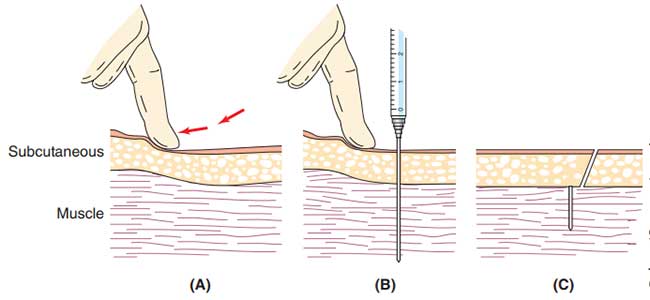The intramuscular (IM) route of drug administration is a common route for parenteral injections. Many antibiotics, preoperative sedatives, and narcotics are administered intramuscularly.
In intramuscular (IM) injections, the medication is deposited deep into the muscle mass, past the dermis and subcutaneous tissue, and into the very deepest layers of the muscle, where the rich blood supply allows for rapid and full absorption. The muscles also contain large blood vessels and nerves, so it is important to place the needle correctly to avoid damage to these structures.
Intramuscular injections are administered at a 90 degree angle with a 22 to 25 guage needle.
There are five recommended sites for intramuscular injections
1. Dorsogluteal: Upper outer quadrant of the buttock (most commonly used for adults, but not for children under 3 years old).
2. Ventrogluteal: Above and to the outside of the buttock area, on the hip.
3. Deltoid: Upper outer arm above the axilla (preferred site for vaccines).
4. Vastus lateralis: Front of the thigh toward the outside of the leg (preferred site for infants younger than 7 months).
5. Rectus femoris: Front of the thigh toward the midline of the leg.
Z-Track Injection Technique
The Z-Track inject technique is used to prevent medication from leaking back in the subcutaneous tissue after the medication has been injected into the patient. This technique is used whenever the medication—such as dextran (iron)—might cause a visible and permanent skin discoloration. The gluteal muscle is the preferred site for a Z-Track injection.

Z-track method of IM injection of iron preparations. (A) Skin and
subcutaneous tissue pulled to one side and held there. (B) Needle is placed in
muscle. (C) Z-track sealed when tissue released.
1. Absorption is more rapid as compared to oral route.
2. This route causes less pain than the i.v. route.
3. Mild irritants, depot injections, soluble substances, and suspensions can be given by this route.
Read Also: Intravenous Route of Drug Administration: Advantages and Disadvantages
4. It is convenient route in administering drugs in animals that are difficult to restrain.
5. It is used in administering aqueous or oleaginous suspensions or solutions.
6. Muscles are highly vascularized thus, the drug could be absorbed hematologenously or through the lymphatic fluid.
1. Intermuscular injection into fascia might lead to erratic absorption of the drug.
2. There is a possibility of improper deposition of drug preparation in nerves, fats, blood vessels, or between muscle bundles in connective sheaths.
3. Aseptic conditions are needed.
4. Intramuscular injections are painful and may cause abscess at the site of injection.
5. Assistance is always required as the drug is to be injected deep in the muscle.
6. There may be injury to the nerves leading to paresis of the muscle that the nerve supplies.
7. Unlike i.v., large volumes cannot be administered.
Comments2
Very well explanary
Thanks for the compliment.